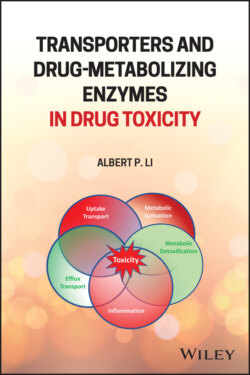Читать книгу Transporters and Drug-Metabolizing Enzymes in Drug Toxicity - Albert P. Li - Страница 9
Оглавление
Preface
A major goal of this book is to provide information to aid the advancement of experimental approaches to ensure drug safety in drug development. It should be of interest to students and researchers in drug metabolism, transport, and toxicology; practitioners in drug development; and governmental regulatory scientists.
The most challenging aspect of drug development is the selection of drug candidates with appropriate safety and efficacy to ensure regulatory approval and market acceptance. The paradigm of demonstration of safety and efficacy in preclinical animal models followed by human clinical trials needs to be refined. The inadequacy of animal models to predict human safety and efficacy is clearly illustrated by the estimated >90% clinical trial failure rate for candidates selected based on results of preclinical trials. Let us ponder this for a minute, despite the extensive time and resources spent in preclinical evaluation, 9 out of 10 candidates selected for clinical trial fail due to a host of factors, with the major ones being unexpected toxicity and/or lack of efficacy. Furthermore, numerous marketed drugs have been withdrawn or have their use limited due to severe, often idiosyncratic, adverse drug toxicity.
This book is intended to present information to overcome this challenge. Failure of preclinical studies to predict human safety and efficacy can be attributed to species differences in drug properties. The inability of clinical trials to eliminate drugs with idiosyncratic drug toxicity is likely due to the inadequate number of subjects employed in regulatory clinical trials to identify drugs causing severe idiosyncratic drug toxicity with an incidence of <1/5000. It is, therefore, of utmost importance to fully understand the key determinants of drug toxicity and apply the knowledge to identify drug candidates with human toxicity as well as to identify the at‐risk human populations.
In this book, drug metabolism enzymes, uptake transporters, and efflux transporters are identified as key contributors of drug toxicity. Species differences in these key parameters result in the failure in the selection of drug candidates with the appropriate properties based on results of preclinical trials, resulting in clinical trial failure. Individuals may succumb to life‐threatening toxicity of marketed drugs due to the chance co‐occurrence of genetic and/or environmental risk factors which may exacerbate drug toxicity. Identification of drug candidates with toxicity exacerbated by known genetic and environmental risk factors must be an approach to be considered in drug development and management of drug administration, hopefully leading to the ultimate elimination of idiosyncratic drug toxicity.
I am grateful to the expert chapter authors who, as a result of their painstaking research, have provided significant progress toward the understanding of the contribution of drug metabolism and transport in drug toxicity.
Albert P. Li, Ph.D.
Columbia, MD
